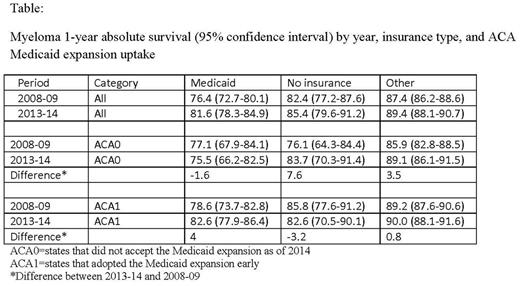Abstract
Introduction: Five year survival rates for patients with multiple myeloma have improved during the first part of the 21st century and the approval of new drugs for myeloma makes it likely that further increases in survival will be observed in the next several years. However, barriers to care, including lack of insurance, may keep some patients from benefiting as much as they could from newer treatments. The Affordable Care Act (ACA), intended to reduce the number of uninsured people in the United States (US), was fully implemented in 2014, although five states took the option of expanding access early. In 2017, survival data from 2014 became available, providing the first chance to evaluate the effect of the ACA on cancer survival. Here, we examine survival for patients with myeloma by insurance type and examine the first survival results comparing survival outcomes in states that accepted the Medicaid expansion versus those that did not.
Methods: Data were drawn from the Surveillance, Epidemiology, and End Results (SEER18) database. Patients with a diagnosis of myeloma (ICD-10 code C90.0) were included. Because the vast majority of patients age 65 and older are covered by Medicare, the analysis was limited to those aged 15 to 64 years. Kaplan-Meier analysis was used to determine 1-year absolute survival. In order to determine if an effect from the Medicaid expansion could be observed, survival by insurance type was calculated for patients who lived in states that accepted early expansion of Medicaid (California, New Jersey, Connecticut, and Washington) versus those that had not accepted the Medicaid expansion as of the end of 2014 (Louisiana, Georgia, Alaska, and Utah.)
Results: One year absolute survival increased overall between the periods studied, going from 85.3% (95% confidence interval 84.2-86.4) in 2008-09 to 87.6% (95% confidence interval 86.4-88.8) in 2013-14 for patients age 15-64. Survival was lower for patients with no insurance or with Medicaid only than for patients with other insurance in all time periods (see table). When states which were early adopters of the Medicaid expansion were compared to those that were not, more patients were insured in the Medicaid expansion states in 2013-14 (3.5% compared to 8.5%), although the rate of non-Medicaid insurance was the same in each group at 77.4% in 2013-14. Survival increased slightly for patients with Medicaid in the Medicaid expansion states, with an increase of 4.0% units compared to a decrease of 1.6% units in the non-expansion states. However, the confidence intervals were large in both populations.
Discussion: One year survival has increased between 2008-09 and 2013-14 for patients with multiple myeloma. Patients with no insurance or with Medicaid have lower survival expectations than patients with other insurance. Fewer patients are uninsured in the states where the ACA Medicaid expansion was adopted. There is a preliminary indication that results for patients using Medicaid may be improving in states that adopted the Medicaid expansion, although the significance of this observation remains in doubt due to the small case numbers. Furthermore, the reasons for these changes are unclear at this time. Further research as more data become available may help clarify this issue.
No relevant conflicts of interest to declare.
Author notes
Asterisk with author names denotes non-ASH members.


This feature is available to Subscribers Only
Sign In or Create an Account Close Modal